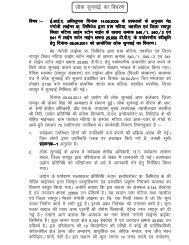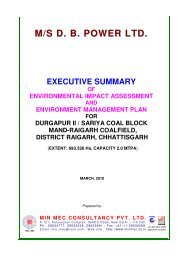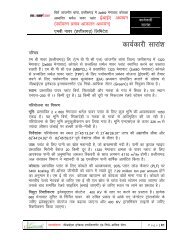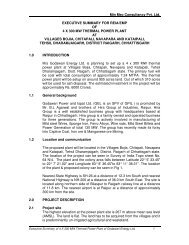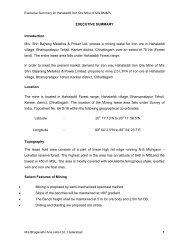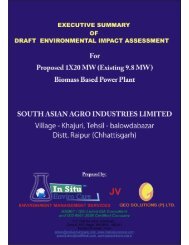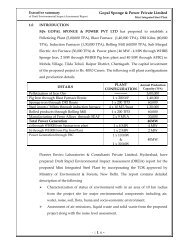Summary EIA Report in English Language - Chhattisgarh ...
Summary EIA Report in English Language - Chhattisgarh ...
Summary EIA Report in English Language - Chhattisgarh ...
Create successful ePaper yourself
Turn your PDF publications into a flip-book with our unique Google optimized e-Paper software.
Executive <strong>Summary</strong>standards. The pH, TDS, and Dissolved Oxygen of the surface water were found <strong>in</strong> rangeof 7.5– 7.6, 56-164 mg/lit and 6.2-6.4 mg/lit respectively, whereas the ground watershowed pH 7.10 -7.67, TDS 155-495 mg/lit.2.4 Land Environment2.5 SoilAbout 37% of the total study area is forest land, 36% is agricultural land, 11% iswaste land and the rema<strong>in</strong><strong>in</strong>g 16% is uncultivable land. .Land use pattern with<strong>in</strong> the study area is given below:Total Area ForestLandIrrigatedLandUnirrigatedLandCulturableWaste LandUnclutivatedLand26651 9763 518 9186 2900 4284The soil quality assessment was carried out at eight locations. The bulk density ofthe soil <strong>in</strong> the study area ranges between 1.32 to 1.43 g/cc, which <strong>in</strong>dicate favorablephysical condition for plant growth. The porosity and water hold<strong>in</strong>g capacity of the soilsare <strong>in</strong> the range of 34.65% to 40% and 31.62 % to 38.66% respectively. Variations <strong>in</strong> thepH of the soil is found to be neutral (6.73 to 7.83), thus conducive for growth of plant.Organic Carbon and Nitrogen are found <strong>in</strong> the range of 0.82 – 2.07% and 266 – 624kg/ha. This shows that soil is moderately good <strong>in</strong> organic and nutrient content.2.6 Flora & FaunaAbout 37% of the study area is covered by forests. Few trees of Sal, Mahuwa, Mo<strong>in</strong> andKarm exist <strong>in</strong> the project area and they will not be cut dur<strong>in</strong>g the construction of thebuild<strong>in</strong>gs.Forests <strong>in</strong> the study area fall under the category of “Tropical Wet DeciduousForest”. Density of the trees <strong>in</strong> the forest areas is quite high while <strong>in</strong> some area thedensity is low. Sal (Shorea robusta) is the predom<strong>in</strong>ant species with Saja (Term<strong>in</strong>aliatomentosa) Arjuna (Term<strong>in</strong>alia arjuna) Tendu (Diospyrox mclanoxylon), Mahua(Madhuca <strong>in</strong>dica), Bija (Pterocarpus marsupium) and Dhaura (Anogeissus latifolia) be<strong>in</strong>gthe ma<strong>in</strong> associates. Sporadic growth of Bamboos occurs <strong>in</strong> the hilly areas.Sight<strong>in</strong>g of wild animals <strong>in</strong> the study area is quite rare. No wild animals exceptlangoors, monkeys, hare, jungle cat and rarely a deer species are seen <strong>in</strong> the remote areasof hilly and rugged forest terra<strong>in</strong> that forms the northern most and the southernmostextremities of the study area. The central portion occupy<strong>in</strong>g comparatively flat low ly<strong>in</strong>garea is occupied by agricultural activity and is moderately populated rear<strong>in</strong>g large herdsof domestic cattle.There is no National Park, Sanctuary, Elephant or Tiger Reserve with<strong>in</strong> 10 kmradius around the project site. No migratory route of wild animals has been reported.2.7 Socio-Economic EnvironmentDemographic data <strong>in</strong>dicates -3



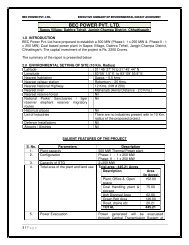
![ks= h; dk;kZy;] {ks= h; dk;kZy](https://img.yumpu.com/50492507/1/190x245/ks-h-dkkzy-ks-h-dkkzy.jpg?quality=85)
